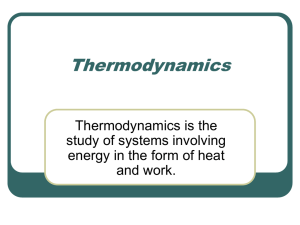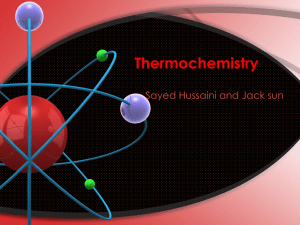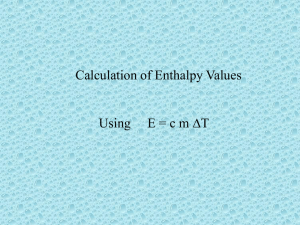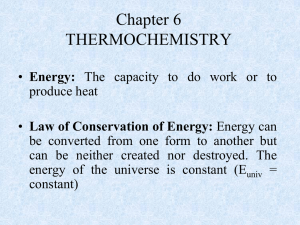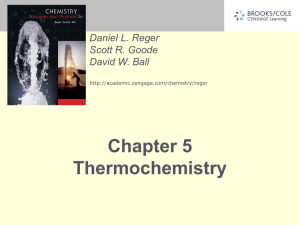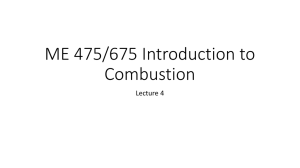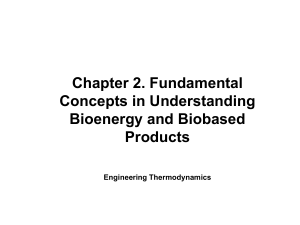Thermochemistry
advertisement
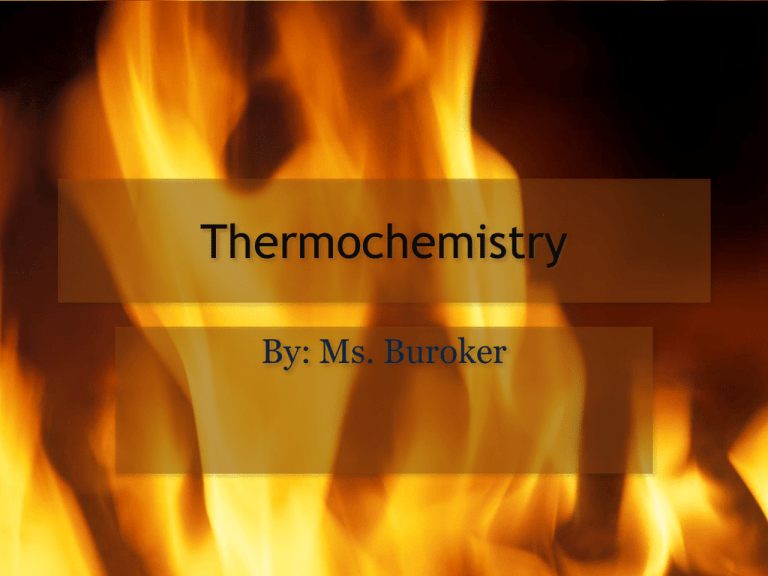
Thermochemistry By: Ms. Buroker Thermochemistry is the study of the relationship between chemical reactions and energy changes. The Nature of Energy We define energy as the capacity to do work or to transfer heat. HEAT is the form of energy that flows between 2 objects because of their difference in temperature. The Law of Conservation of Energy states that energy can be converted from one form to another but can be neither created nor destroyed. The Nature of Energy Some Definitions …. • Thermal Energy: energy associated with the random motion of molecules • Chemical Energy: energy “stored” due to the structure of chemical substances • Kinetic Energy: energy of motion • Potential Energy: available energy due to an object’s position • Radiant Energy: energy in the form of electromagnetic radiation Potential Energy Potential Energy: energy due to position or composition. “Stored” energy resulting from attractions and repulsions an object experiences in relation to other objects. 1.) Electrostatic Forces between charged particles 2.) Chemical Energy 3.) Thermal Energy Kinetic Energy Kinetic Energy: energy in motion Ek = ½ mv2 Mass Velocity Potential and Kinetic Enegry Potential Energy can be converted to kinetic energy and do work in the process. Units of Energy: SI Unit: Joule, (J) 1J = 1kg-m2/s2 Cgs Unit: Erg 1Erg = 1g-cm2/s2 Units of Energy The joule is not very large, so energies associated with chemical reactions are commonly expressed in kJ. Non- SI Base Unit commonly used … calorie (cal) Calorie = the amount of energy required to raise the temperature of 1g of water 1○C. 1 cal = 4.184J (exactly) Internal Energy of the System Kinetic (thermal) energy: Translational Rotational Vibrational Potential Energy: Nuclear Forces Electrostatic attractions (Chemical energy): Intramolecular - Bonds between atoms Intermolecular - Attractions between molecules Temperature vs. Heat Temperature: a property that reflects the random motions of the particles in a particular substance. Heat: involves the transfer of energy between two objects due to a temperature difference … it is NOT a substance contained in the object! Temperature vs. Heat Continued… The more thermal energy a substance has, the greater the motion of its atoms and molecules. The total thermal energy in an object is the sum of the individual energies of all the atoms, molecules, or ions in that object. So … The thermal energy of a given substance depends not only on temperature but also on the amount of substance. (E.g. Warm bath vs. hot coffee) State Function A State Function or State Property is a property of a system that depends only on its present state. * It does not depend on how the system arrived at the present state, it depends only on the characteristics of the present state. * A change in this function or property in going from one state to another state is independent of the particular pathway taken between the two states. An Example of a State Function Elevation on the earth’s surface vs. distance between to points. Chicago (elevation 674 ft) Denver (elevation 5280 ft) Elevation = State Function Distance = Not a State Function Energy, Pressure, Volume, and Temperature are State Functions. Energy is a state function while, heat and work are NOT!!!! System and Surrounding System: the portion we single out for our study Surrounding: everything else • When studying chemical reactions … the chemicals are the system and the containers and everything else are the surroundings. CH4(g) + 2O2(g) CO2(g) + 2H2O(g) + energy(heat) Three Types of Systems 1. Open system is one in which both matter and energy (usually in the form of heat) are “flowing into and out of the system from the surroundings, i.e., there is exchange of mass and energy with its surroundings. 2. Closed system is one in which matter does NOT flow into or out of the system but energy does flow, i.e., there can be an exchange of energy but not of mass. 3. Isolated system is one in which neither mass nor energy can flow from surroundings to the system or from the system to the surroundings, i.e., there is no exchange of either mass or energy . Thermal Equilibrium Heat transfer occurs when two objects at different temperatures are brought into contact. Heat energy is transferred until the system comes to thermal equilibrium. Within a system, the heat lost by the hotter object is equal to the heat gained by the cooler object. When heat transfer occurs across the boundary between a system and the surrounding, the directionality of the heat transfer is described as: Exothermic: heat is transferred from a system to the surroundings … means “out of” (negative) Endothermic: Heat is transferred from the surroundings to the system … means “in to” (positive) The First Law of Thermodynamics The energy of the universe is constant. Internal Energy, E, of a system can be defined most precisely as the sum of the kinetic and potential energies of all the “particles” in the system. ∆E = Eproducts – Ereactants ∆E = q + w Heat Transfer work Specific Heat Capacity and Energy Transfer Specific Heat: The amount of energy required to increase one gram of a substance by 1K (or oC) ∆E = q + w The sign reflects the system’s point of view. If energy flows into the system via heat … q is positive and is thus an endothermic process. If energy flows out of the system via heat … q is negative and is thus an exothermic process. Specific Heat and Energy Transfer Endothermic vs. Exothermic Sample Problems 1. In an experiment it was determined that 59.8J was required to change the temperature of 25.0g of ethylene glycol (a compound used as antifreeze in automobile engines) by 1.00K. Calculate the specific heat capacity of ethylene glycol from these data. 2. A 15.5g piece of chromium, heated to 100.0oC, is dropped into 55.5g of water at 16.5oC. The final temperature of the metal and the water is 18.9oC. What is the specific heat capacity of chromium? (Assume no heat is lost to the container or to the surrounding air.) 3. A piece of iron (400.g) is heated in a flame and then dropped into a beaker containing 1,000.g of water. The original temperature of the water was 20.0oC, and the final temperature of the water and iron is 32.8oC after thermal equilibrium has been attained. What was the original temperature of the hot iron bar? (Assume no heat is lost to the beaker or to the surrounding air.) You need the specific heat capacity of iron = 0.449J/gK Answer: Sample Problem #1 Sample Problems 1. In an experiment it was determined that 59.8J was required to change the temperature of 25.0g of ethylene glycol (a compound used as antifreeze in automobile engines) by 1.00K. Calculate the specific heat capacity of ethylene glycol from these data. Answer: q= c x m x DT Specific Heat Capacity Units = J/gK 59.8J / [(25.0g)(1.00K)] = 2.39 J/gK Answer: Sample Problem #2 Sample Problems 2. A 15.5g piece of chromium, heated to 100.0oC, is dropped into 55.5g of water at 16.5oC. The final temperature of the metal and the water is 18.9oC. What is the specific heat capacity of chromium? (Assume no heat is lost to the container or to the surrounding air.) Answer: Heat lost by chromium: -q = C(15.5g)(18.9oC – 100.0oC) = -1257.05(C) Heat gained by water: q = (55.5g)(4.184J/goC)(18.9oC – 16.5oC) = 557.309J 1257.05g(C) = 557.309J C = 557.309 / 1257.05 = .443J/goC Answer: Sample Problem #3 Sample Problems 3. A piece of iron (400.g) is heated in a flame and then dropped into a beaker containing 1,000.g of water. The original temperature of the water was 20.0oC, and the final temperature of the water and iron is 32.8oC after thermal equilibrium has been attained. What was the original temperature of the hot iron bar? (Assume no heat is lost to the beaker or to the surrounding air.) You need the specific heat capacity of iron = 0.449J/gK Answer: Ti = 330.992oC = 331oC Phase Changes Solid → Liquid →Gas Heat of Fusion: Heat required to convert a solid at its melting point to a liquid Heat of Vaporization: Heat required to convert a liquid at its boiling point to a gas. Heat of Sublimation: Heat required to take a substance directly from its solid to its gas state. Note that the temperature of a substance does not change as it is going through a phase change. Example Problem How much heat must be absorbed to warm 25.0g of liquid methanol, CH3OH, from 25.0oC to its boiling point (64.6oC) and then to evaporate the methanol completely at that temperature? The specific heat capacity of liquid methanol is 2.53J/gK. The heat of vaporization of methanol is 2.00kJ/g Answer: Step 1 q1 =c x m x DT q1 = (2.53J/gK) x (25.0g) x (64.6oC – 25.0oC) q1 = 2504.7J Step 2 q2 = 25.0g (2000.0J/g) q2= 50,000J Work Associated with Chemical Processes Work done by a gas … expansion Work done to a gas … compression W = -P∆V P= external pressure -∆V= compression +∆V= expansion NOTE: For an ideal gas, work can occur ONLY when its volume changes. Thus, if a gas is heated at constant volume, the pressure increases but no work occurs. Enthalpy Thermodynamics defines a new function: ENTHALPY(H) (q p) as the heat flow part of the change in internal energy when the pressure is kept constant as it is in an open container or in an expandable container. DE = q - P (DV) DE = q p - P (DV) (q p is given the name Enthalpy and the symbol (H)) DE = DH - P (DV) or re-arrange to express it: DH = DE + P (DV) = Change in Enthalpy Enthalpy Continued At constant pressure, the change in enthalpy of the system is equal to the energy flow as heat. DH = qp DH = Hproducts - Hreatctants Note: DH = qp ONLY at constant pressure … the change in enthalpy of a system has no easily interpreted meaning except at constant pressure, where DH = heat. At constant pressure, exothermic means DH is negative ; endothermic means DH is positive. Enthalpy Changes For Chemical Reactions Enthalpy (heat) of Reactions Enthalpy changes accompany chemical Reactions: H2O(g) → H2(g) + ½ O2(g) DH = +241.8kJ (Endothermic) For the opposite reaction … H2(g) + ½ O2(g) → H2O(g) H = -241.8kJ (Exothermic) Calorimetry The devise used to determine the heat associated with a chemical reaction is called a calorimeter. Calorimetry is the science of measuring heat, based on the temperature change a body undergoes when it absorbs or discharges energy as heat. Heat Capacity The heat capacity of a substance, is defined as: C = heat absorbed increase in temperature Specific Heat Capacity: the energy required to raise the temperature of one gram of a substance by one degree Celsius. Molar Heat Capacity: the energy required to raise the temperature of one mole of a substance by one degree Celsius. Coffee Cup Calorimetry Simple way of measuring heat. Two Styrofoam cups are nested together where the inner cup holds the solution in which the reaction takes place. An example of constant-pressure calorimetry. Used in determining the changes in enthalpy for reactions occurring in solution. Remember!! Under the conditions of constant pressure … enthalpy equals heat! Bomb Calorimetry Constant- Volume Calorimetry qreaction = -Ccal x DT Calorimeter Constant Bomb Calorimetry …. E = qv = qrxn = -(qbomb + qwater) The energy transferred to the bomb is given by the heat capacity (usually in J/K) The energy transferred to the water is given by the specific heat equation: qwater = m x C x T Example Problems 1. Assume you mix 200.mL of 0.400M HCl with 200.mL of 0.400M NaOH in a coffee-cup calorimeter. The temperature of the solutions before mixing was 25.10oC; after mixing and allowing the reaction to occur, the temperature is 27.78oC. What is the molar enthalpy of neutralization of the acid? (Assume that the densities of all solutions are 1.00g/mL and their specific heat capacities are 4.20 J/gK) 2. A 1.00g sample of ordinary table sugar (sucrose C12H22O11) is burned in a bomb calorimeter. The temperature of 1.50x103g of water in the calorimeter rises from 25.00oC to 27.32oC. The heat capacity of the bomb is 837J/K, and the specific heat of the water is 4.20J/gK. a) Calculate the heat evolved per gram of sucrose. b) Calculate the heat evolved per mole of sucrose. Answer: Sample Problem #1 1. Assume you mix 200. mL of 0.400M HCl with 200. mL of 0.400M NaOH in a coffee-cup calorimeter. The temperature of the solutions before mixing was 25.10oC; after mixing and allowing the reaction to occur, the temperature is 27.78oC. What is the molar enthalpy of neutralization of the acid? (Assume that the densities of all solutions are 1.00g/mL and their specific heat capacities are 4.20 J/gK) HCl + NaOH → NaCl + H2O Total volume of solutions = 200.mL + 200.mL = 400.mL Total mass = 400.mL (1g/mL) = 400.g Moles of HCl and NaOH (each) = .200L (0.400mol/L) = .0800mol q = (400.g)(4.20J/gK)(27.78oC – 25.10oC) = 4502.4J Molar enthalpy = 4502.4J / .0800mol = 56,280J/mol = 56.3kJ/mol Answer: Sample Problem #2 2. A 1.00g sample of ordinary table sugar (sucrose C12H22O11) is burned in a bomb calorimeter. The temperature of 1.50x103 g of water in the calorimeter rises from 25.00oC to 27.32oC. The heat capacity of the bomb is 837J/K, and the specific heat of the water is 4.20J/gK. a) Calculate the heat evolved per gram of sucrose. b) Calculate the heat evolved per mole of sucrose. a) Temperature change = 27.32oC – 25.00oC = 2.32oC qwater = (1500g)(4.20J/gK)(2.32oC) = 14,616J qbomb = 837J/K(2.32oC) = 1,941.84J qrxn = -(14,616J + 1,941.84J) = -16,557.8J = -16.6kJ/g b) Moles sucrose = 1.00g / (342.2965g/mol) = 2.921x10-3mol qrxn = -16,557.8J / 2.921x10-3mol = 5.6685x106J/mol = 5.67x103kJ/mol Hess’s Law Since enthalpy is a state function, the change in enthalpy in going from some initial state to some final state is independent of the pathway….. So, in going from a particular set of reactants to a particular set of products, the change in enthalpy is the same whether the reaction takes place in one step or in a series of steps. Characteristics of Hess’s Law 1.) If a reaction is reversed, the sign of DH is also reversed. 2.) The magnitude of DH is directly proportional to the quantities of reactants and products in a reaction. If the coefficients in a balanced reaction are multiplied by an integer, the value of DH is multiplied by the same integer. Example: Given the reaction information to the left, determine the unknown enthalpy of reaction “a”. Answer: Ha + -283.0kJ = -393.5kJ Ha = -110.5kJ Example Problem #1 Use Hess’s law to calculate the enthalpy change for the formation of CS2(l) from C(s) and S(s) from the following enthalpy values: C(s) + O2(g) → CO2(g) DH = -393.5kJ S(s) + O2(g) → SO2(g) DH = -296.8kJ CS2(l) + 3 O2(g) → CO2(g) + 2 SO2(g) C(s) + 2 S(s) → CS2(l) DH = -1103.9kJ DH = ? Hint: Remember you can reverse and multiply equations through. Whatever you do to the reaction equation, you do to the enthalpy. Answer: Example Problem #1 Use Hess’s law to calculate the enthalpy change for the formation of CS2(l) from C(s) and S(s) from the following enthalpy values: C(s) + O2(g) → CO2(g) DH = -393.5kJ S(s) + O2(g) → SO2(g) DH = -296.8kJ CS2(l) + 3 O2(g) → CO2(g) + 2 SO2(g) DH = -1103.9kJ C(s) + 2 S(s) → CS2(l) DH = ? C(s) + O2(g) → CO2(g) DH = -393.5kJ 2S(s) + 2O2(g) → 2SO2(g) DH = -593.6kJ (Double) CO2(g) + 2 SO2(g) → CS2(l) + 3 O2(g) DH = 1103.9kJ (Reverse) C(s) + 2 S(s) → CS2(l) H = -393.5kJ + -593.6kJ + 1103.9kJ = 116.8kJ Example #2 Diborane (B2H6) is a highly reactive boron hydride that was once considered as a possible rocket fuel for the U.S. space program. Calculate DH for the synthesis of diborane from its elements, according to the equation: 2B(s) + 3H2(g) B2H6(g) Use the following data: (a) 2B(s) + 3/2O2(g) B2O3(s) DH= -1273kJ (b) B2H6(g) + 3O2(g) B2O3(s) + 3H2O(g) DH = -2035kJ (c) H2(g) + 1/2O2(g) H2O(l) DH = -286kJ (d) H2O(l) H2O(g) DH = 44kJ Hints for using Hess’s Law Hint #1: Work backward from the required reaction, using the reactants and products to decide how to manipulate the other given reaction at your disposal. Hint #2: Reverse any reactions needed to give the required reactants and products. Hint #3: Multiply reactions to give the correct number of reactants and products. Standard Enthalpies of Formation Standard enthalpy of formation (DHºf) for a compound is the change in enthalpy that accompanies the formation of one mole of a compound from its elements with all substances in their standard states. The degree symbol on a thermodynamic function, for example, DHºf, indicates that the corresponding process has been carried out under standard conditions. The standard state for a substance is a precisely defined reference state. Calculation DHºreaction = SnpDHºf(products) – SnrDHºf(reactants) Elements in their standard states are not included in the DHreaction calculations. That is, DHºf, for an element in its standard state is zero. Sample Problem Calculate the standard enthalpy of combustion for benzene, C6H6. C6H6(l) + 7.5 O2(g) → 6 CO2(g) + 3 H2O(l) Horxn = ? Hof[C6H6(l)] = +49.0kJ/mol. Other values needed can be found in the appendix in the back of your book. Horxn = [6(-393.51) + 3(-285.83)] – [1(49.0) + 7.5(0)] = -3,267.55 = -3.27x103kJ/mol




